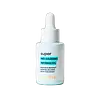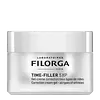What's inside
What's inside
 Key Ingredients
Key Ingredients

 Benefits
Benefits

 Concerns
Concerns

 Ingredients Side-by-side
Ingredients Side-by-side

Water
Skin ConditioningGlycerin
HumectantPropanediol
SolventButylene Glycol
HumectantPolyacrylate Crosspolymer-6
Emulsion StabilisingCopper Tripeptide-1
Skin ConditioningPalmitoyl Tripeptide-1
Skin ConditioningPalmitoyl Tripeptide-38
Skin ConditioningPalmitoyl Tetrapeptide-7
Skin ConditioningCarnosine
Skin ConditioningHyaluronic Acid
HumectantSodium Hyaluronate
HumectantCarbomer
Emulsion StabilisingPolysorbate 20
EmulsifyingHydroxypropyl Cyclodextrin
MaskingHydrolyzed Brazil Nut Protein
Skin ConditioningCopper Picolinate
SoothingPhenoxyethanol
PreservativePotassium Sorbate
PreservativeEthylhexylglycerin
Skin ConditioningAlcohol
AntimicrobialSodium Benzoate
MaskingSodium Hydroxide
BufferingCitric Acid
BufferingWater, Glycerin, Propanediol, Butylene Glycol, Polyacrylate Crosspolymer-6, Copper Tripeptide-1, Palmitoyl Tripeptide-1, Palmitoyl Tripeptide-38, Palmitoyl Tetrapeptide-7, Carnosine, Hyaluronic Acid, Sodium Hyaluronate, Carbomer, Polysorbate 20, Hydroxypropyl Cyclodextrin, Hydrolyzed Brazil Nut Protein, Copper Picolinate, Phenoxyethanol, Potassium Sorbate, Ethylhexylglycerin, Alcohol, Sodium Benzoate, Sodium Hydroxide, Citric Acid
Water
Skin ConditioningGlycerin
HumectantPropylheptyl Caprylate
EmollientSilica
AbrasiveDicaprylyl Carbonate
EmollientSqualane
EmollientImperata Cylindrica Root Extract
Skin ConditioningHydroxyethyl Acrylate/Sodium Acryloyldimethyl Taurate Copolymer
Emulsion StabilisingZinc PCA
HumectantPolyacrylate Crosspolymer-6
Emulsion StabilisingPhenoxyethanol
PreservativeButylene Glycol
HumectantSucrose Palmitate
Emollient1,2-Hexanediol
Skin ConditioningParfum
MaskingCetyl Alcohol
EmollientStearalkonium Hectorite
Gel FormingCaprylic/Capric Triglyceride
MaskingGlyceryl Linoleate
EmollientTocopheryl Acetate
AntioxidantPropylene Carbonate
SolventPolysorbate 60
EmulsifyingSorbitan Isostearate
EmulsifyingBiosaccharide Gum-1
HumectantCarbomer
Emulsion StabilisingSodium Phytate
Hydrogenated Vegetable Oil
EmollientAdenosine
Skin ConditioningAnigozanthos Flavidus Extract
Skin ConditioningBenzyl Alcohol
PerfumingSodium Lactate
BufferingSodium Hydroxide
BufferingCaprylyl Glycol
EmollientDipeptide Diaminobutyroyl Benzylamide Diacetate
Skin ConditioningGlyceryl Caprylate
EmollientLevulinic Acid
PerfumingCitric Acid
BufferingT-Butyl Alcohol
PerfumingPolysorbate 20
EmulsifyingPotassium Sorbate
PreservativeSodium Citrate
BufferingSodium Hyaluronate
HumectantCrithmum Maritimum Extract
Skin ConditioningP-Anisic Acid
MaskingTocopherol
AntioxidantAcrylates/C10-30 Alkyl Acrylate Crosspolymer
Emulsion StabilisingPalmitoyl Tripeptide-1
Skin ConditioningPalmitoyl Tetrapeptide-7
Skin ConditioningWater, Glycerin, Propylheptyl Caprylate, Silica, Dicaprylyl Carbonate, Squalane, Imperata Cylindrica Root Extract, Hydroxyethyl Acrylate/Sodium Acryloyldimethyl Taurate Copolymer, Zinc PCA, Polyacrylate Crosspolymer-6, Phenoxyethanol, Butylene Glycol, Sucrose Palmitate, 1,2-Hexanediol, Parfum, Cetyl Alcohol, Stearalkonium Hectorite, Caprylic/Capric Triglyceride, Glyceryl Linoleate, Tocopheryl Acetate, Propylene Carbonate, Polysorbate 60, Sorbitan Isostearate, Biosaccharide Gum-1, Carbomer, Sodium Phytate, Hydrogenated Vegetable Oil, Adenosine, Anigozanthos Flavidus Extract, Benzyl Alcohol, Sodium Lactate, Sodium Hydroxide, Caprylyl Glycol, Dipeptide Diaminobutyroyl Benzylamide Diacetate, Glyceryl Caprylate, Levulinic Acid, Citric Acid, T-Butyl Alcohol, Polysorbate 20, Potassium Sorbate, Sodium Citrate, Sodium Hyaluronate, Crithmum Maritimum Extract, P-Anisic Acid, Tocopherol, Acrylates/C10-30 Alkyl Acrylate Crosspolymer, Palmitoyl Tripeptide-1, Palmitoyl Tetrapeptide-7
Ingredients Explained
These ingredients are found in both products.
Ingredients higher up in an ingredient list are typically present in a larger amount.
Butylene Glycol (or BG) is used within cosmetic products for a few different reasons:
Overall, Butylene Glycol is a safe and well-rounded ingredient that works well with other ingredients.
Though this ingredient works well with most skin types, some people with sensitive skin may experience a reaction such as allergic rashes, closed comedones, or itchiness.
Learn more about Butylene GlycolCarbomer is a polymer of acrylic acid. Its main role is to create a gel consistency.
A high amount of carbomer can cause pilling or balling up of products. Don't worry, most products contain 1% or less of carbomer.
Citric Acid is an alpha hydroxy acid (AHA) naturally found in citrus fruits like oranges, lemons, and limes.
Like other AHAs, citric acid can exfoliate skin by breaking down the bonds that hold dead skin cells together. This helps reveal smoother and brighter skin underneath.
However, this exfoliating effect only happens at high concentrations (20%) which can be hard to find in cosmetic products.
Due to this, citric acid is usually included in small amounts as a pH adjuster. This helps keep products slightly more acidic and compatible with skin's natural pH.
In skincare formulas, citric acid can:
While it can provide some skin benefits, research shows lactic acid and glycolic acid are generally more effective and less irritating exfoliants.
Most citric acid used in skincare today is made by fermenting sugars (usually from molasses). This synthetic version is identical to the natural citrus form but easier to stabilize and use in formulations.
Read more about some other popular AHA's here:
Learn more about Citric AcidGlycerin is already naturally found in your skin. It helps moisturize and protect your skin.
A study from 2016 found glycerin to be more effective as a humectant than AHAs and hyaluronic acid.
As a humectant, it helps the skin stay hydrated by pulling moisture to your skin. The low molecular weight of glycerin allows it to pull moisture into the deeper layers of your skin.
Hydrated skin improves your skin barrier; Your skin barrier helps protect against irritants and bacteria.
Glycerin has also been found to have antimicrobial and antiviral properties. Due to these properties, glycerin is often used in wound and burn treatments.
In cosmetics, glycerin is usually derived from plants such as soybean or palm. However, it can also be sourced from animals, such as tallow or animal fat.
This ingredient is organic, colorless, odorless, and non-toxic.
Glycerin is the name for this ingredient in American English. British English uses Glycerol/Glycerine.
Learn more about GlycerinPalmitoyl Tetrapeptide-7 (formerly Palmitoyl Tetrapeptide-3) is a lab-made peptide with anti-inflammatory and skin-repairing benefits. It's made up of four amino acids (glycine, glutamine, proline, and arginine) and palmitic acid (which helps it penetrate skin more effectively).
This ingredient helps reduce inflammation by limiting the production of interleukin-6 (IL-6), a chemical that triggers inflammatory responses, particularly after UV exposure.
Less inflammation = slower collagen breakdown and a longer-lasting, youthful appearance.
Palmitoyl Tetrapeptide-7 also stimulates collagen production and supports a healthier skin barrier.
Over time, this can improve skin firmness, hydration, and reduce the appearance of fine lines. It’s commonly paired with Palmitoyl Tripeptide-1 in the well-known Matrixyl 3000 complex for enhanced anti-aging effects.
This ingredient has been shown to be effective and safe in cosmetic use and you'll typically find it in small amounts (less than 0.01%).
Due to its palmitic acid base, it may not be safe for Malassezia folliculitis.
Read more about other common types of peptides here:
Learn more about Palmitoyl Tetrapeptide-7Palmitoyl Tripeptide-1 is also known as pal-GHK. It is made up of 3 amino acids and palmitic acid, a fatty acid that helps it absorb into skin more easily.
This peptide is as a signal peptide, meaning it tells the skin to produce more collagen. Collagen is the key protein that helps form the skin's structure and keep it plump, firm, and hydrated.
By boosting collagen production, this ingredient supports a stronger skin barrier and helps reduce the appearance of wrinkles.
You'll most likely see this ingredient paired with Palmitoyl Tetrapeptide-7 in the well-known Matrixyl 3000 complex. While results from in-house testing should be viewed cautiously, this peptide duo is among the most studied and widely used in modern skincare.
Due to its palmitic acid base, this ingredient may not be safe for Malassezia folliculitis.
Read more about other common types of peptides here:
Learn more about Palmitoyl Tripeptide-1Phenoxyethanol is a preservative that has germicide, antimicrobial, and aromatic properties. Studies show that phenoxyethanol can prevent microbial growth. By itself, it has a scent that is similar to that of a rose.
It's often used in formulations along with Caprylyl Glycol to preserve the shelf life of products.
Polyacrylate Crosspolymer-6 is a texture enhancer and pH adjuster.
It is be used to thicken water-based products and create a gel-texture with a velvet feel.
One manufacturer claims this ingredient to have a pH range of 2-8 and to be biodegradable.
Learn more about Polyacrylate Crosspolymer-6Polysorbate 20 is made by combining ethoxylation of sorbitan, ethylene oxide, and lauric acid. It is a mild cleansing agent, surfactant, and emulsifier.
As a surfactant, it helps collect dirt and oils for washing. Emulsifiers prevent oils and water from separating.
Polysorbate 20 also adds scent to a product. Since it is made using sorbitol, it has a sweet scent. Sorbitol can also be found in fruits such as apples and peaches.
The lauric acid used to create Polysorbate 20 is often derived from coconuts.
Polysorbate 20 may not be fungal acne safe.
Learn more about Polysorbate 20Potassium Sorbate is a preservative used to prevent yeast and mold in products. It is commonly found in both cosmetic and food products.
This ingredient comes from potassium salt derived from sorbic acid. Sorbic acid is a natural antibiotic and effective against fungus.
Both potassium sorbate and sorbic acid can be found in baked goods, cheeses, dried meats, dried fruit, ice cream, pickles, wine, yogurt, and more.
You'll often find this ingredient used with other preservatives.
Learn more about Potassium SorbateSodium Hyaluronate is hyaluronic acid's salt form. It is commonly derived from the sodium salt of hyaluronic acid.
Like hyaluronic acid, it is great at holding water and acts as a humectant. This makes it a great skin hydrating ingredient.
Sodium Hyaluronate is naturally occurring in our bodies and is mostly found in eye fluid and joints.
These are some other common types of Hyaluronic Acid:
Learn more about Sodium HyaluronateSodium Hydroxide is also known as lye or caustic soda. It is used to adjust the pH of products; many ingredients require a specific pH to be effective.
In small amounts, sodium hydroxide is considered safe to use. However, large amounts may cause chemical burns due to its high alkaline.
Your skin has a natural pH and acid mantle. This acid mantle helps prevent harmful bacteria from breaking through. The acid mantle also helps keep your skin hydrated.
"Alkaline" refers to a high pH level. A low pH level would be considered acidic.
Learn more about Sodium HydroxideWater. It's the most common cosmetic ingredient of all. You'll usually see it at the top of ingredient lists, meaning that it makes up the largest part of the product.
So why is it so popular? Water most often acts as a solvent - this means that it helps dissolve other ingredients into the formulation.
You'll also recognize water as that liquid we all need to stay alive. If you see this, drink a glass of water. Stay hydrated!
Learn more about Water